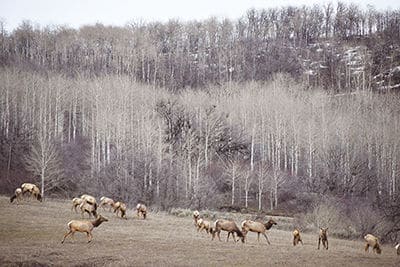It’s always in the gloaming.
That’s when they return. Often barely visible. As if guided by the ticking of an internal clock in the fall and spring, they appear in a beautiful, heart-stopping instant. Suddenly, you look up and there they are. Regal and serene at dusk.
The elk. The pair of ducks.
First, this spring, it was the mallard ducks. One day a male and female were floating on the backyard pond. The male, green-plumed, its body an artist’s palate of colors, worked the weeds for food and nesting material. The female swam nearby, like a mottled brown construction superintendent, camouflaged by nature to be almost indistinguishable to predators, even those with a camera. The male’s colors brighten during this mating season as each duck chooses its mate. The female needs to be obscure. A nest will be built and the female will lay eggs then warm and guard them with her body.
A duck’s young are precocial and will take to the water almost immediately. That will be the next sight to behold. Then, all of them will take flight and leave in late fall.
The elk arrived in the fall. Almost every night at dusk a magnificent herd appeared literally out of nowhere, as if dropped from the candescent sky into a meadow near my house.
They grazed lazily in the alpine meadow beneath a deep forest of aspens and fir trees. I would watch them until darkness fell, so mesmerized that occasionally I would suddenly realize I had stopped breathing.
Then one night they did not return. Snow had begun to fall. Winter at hand, they retreated deep into the woods
Then last week, as if summoned by the swift wave of a magician’s wand, they were back, the cows and last year’s calves. Again, they grazed nonchalantly in the meadow. The elk have a strange yellow color splattered all over their bodies. By fall, they will be dark brown. New calves will foal in late May to June. When the babies are born they are scentless and unlike the ducklings they hide for several weeks.
Coyotes and mountain lions live here, too. Often are the coyotes heard. Rarely are they seen. Spying a mountain lion is even rarer. But they are eerily and frighteningly omnipresent.
One day soon at least one bull, sometimes two, will appear and stand almost hidden in the trees while the herd grazes.
These are the wonders of nature and country life. I grew up in a city, albeit a small one, and I find myself pondering how I came to love and appreciate watching wildlife and trying to understand the language and movements in nature.
How do the ducks know it’s time to fly south, and where do the elk seek shelter deep in the mountains to endure and wait out winter’s storms?
The lives of these and other animals have a quotidian rhythm just as humans’ days unfold in routines, but it’s the seasonal repetition in animal behavior that I find fascinating. We have brains and intellect. They have formidable instincts.
Believe as we may that we are in charge, these fascinating occurrences in nature tell me someone else, a Higher Power, is orchestrating all of it. Much of the beauty of all of these things lies in knowing that we will likely never find many of the answers we seek.
Richard Connor is president and publisher of the Fort Worth Business Press. Contact him at rconnor@bizpress.net






